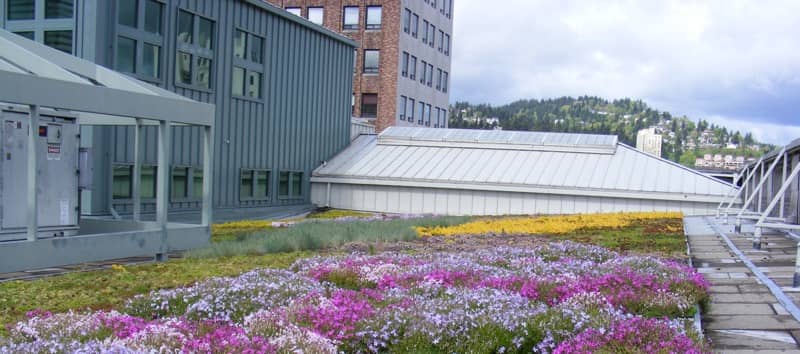 Stormwater management is arguably one of the more beneficial aspects of installing green roofing systems, especially in metropolitan areas. When it rains, runoff flows directly into stormwater systems and nearby waterways. Excessive rainfall can result in strains on these systems which can lead to flooding. Green roofing systems however, absorb a certain amount of rainwater during a storm and then release it slowly, if at all, as to not overpower the city’s water infrastructure.
Stormwater management is arguably one of the more beneficial aspects of installing green roofing systems, especially in metropolitan areas. When it rains, runoff flows directly into stormwater systems and nearby waterways. Excessive rainfall can result in strains on these systems which can lead to flooding. Green roofing systems however, absorb a certain amount of rainwater during a storm and then release it slowly, if at all, as to not overpower the city’s water infrastructure.
Traditional roofing systems are designed to immediately expel water. This is great for the roof itself and the overall structure of the building, but can negatively impact the surrounding community depending on the density of the building population. More buildings means there is less soil to absorb water, which then leads to flooding and uncontrolled discharge of untreated waste into rivers, streams and other bodies of water. Not beneficial for people who rely on the bodies of water for their drinking water.
How Do They Work?
Two terms describe how stormwater is handled by green roofing systems. ‘Retained’ stormwater is rainwater held on the roof and not released to the storm drain system. This water evaporates and/or is used by the plants. ‘Detained’ stormwater is delayed on the roof by the green roof assembly and eventually flows off the roof into the local stormwater system.
Different Categories
Green roofing systems can be classified three ways: extensive, semi-intensive and intensive systems. Below is a helpful chart that depicts the main differences between the three systems.
| Extensive | Semi-Intensive | Intensive | |
Purpose |
Environmental Benefits | Diversity, Habitat | Garden, Amenity Space |
Plant Types |
Mosses, Sedums, Succulents, Herbs and Few Grasses |
Selected Perennials, Sedums, Ornamental Grasses, Herbs and Little Shrubs |
Perennials, Lawn, Putting Green, Shrubs, Trees and Rooftop Farming |
Media Depth |
3-5 inches | 5-8 inches | 8+ inches |
Another differentiator between extensive and intensive green roofing systems is their ability to be used by people. Both systems have specific areas for maintenance, however extensive roofing systems are otherwise limited to people due to the fact that the soil and vegetation is growing in a medium that is less than six inches in depth. Intensive roofing systems incorporate public access into their spaces.
If you choose to add a green roofing system to your building, be sure to consult the appropriate experts prior to signing off on a project. The structural stability of your current building will need to be assessed among other factors to determine if a vegetated roof is best for you.
What are other benefits of green roofing systems? Share your thoughts in the comments.
-1.png?width=500&height=271&name=FiberTite_Only%20(500px%20wide)-1.png)


-1.png)